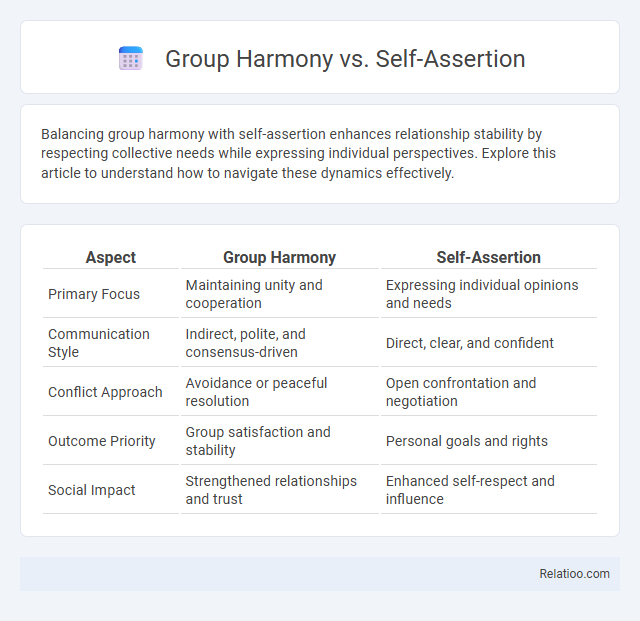Balancing group harmony with self-assertion enhances relationship stability by respecting collective needs while expressing individual perspectives. Explore this article to understand how to navigate these dynamics effectively.
Table of Comparison
| Aspect | Group Harmony | Self-Assertion |
|---|---|---|
| Primary Focus | Maintaining unity and cooperation | Expressing individual opinions and needs |
| Communication Style | Indirect, polite, and consensus-driven | Direct, clear, and confident |
| Conflict Approach | Avoidance or peaceful resolution | Open confrontation and negotiation |
| Outcome Priority | Group satisfaction and stability | Personal goals and rights |
| Social Impact | Strengthened relationships and trust | Enhanced self-respect and influence |
Understanding Group Harmony: Definition and Importance
Group harmony refers to the state of mutual respect, cooperation, and emotional balance within a team or social group, essential for fostering a positive and productive environment. Understanding group harmony involves recognizing its role in reducing conflicts, enhancing communication, and promoting collective well-being. Your ability to prioritize group harmony can lead to stronger relationships and improved collaboration in both personal and professional settings.
The Value of Self-Assertion in Personal Growth
Self-assertion plays a crucial role in personal growth by enabling individuals to express their thoughts and needs confidently, fostering self-awareness and resilience. Balancing self-assertion with group harmony and affiliation helps maintain healthy relationships while promoting individual empowerment and emotional well-being. Developing assertiveness skills enhances decision-making, boundary-setting, and intrinsic motivation, essential for achieving personal and professional goals.
Cultural Perspectives: Harmony versus Individualism
Group harmony is highly valued in collectivist cultures such as Japan and China, where maintaining social cohesion and minimizing conflict are prioritized over self-assertion. In contrast, individualistic cultures like the United States and Western Europe emphasize self-assertion, encouraging personal goals and self-expression even at the expense of group consensus. Affiliation plays different roles depending on cultural contexts; in collectivist societies, it strengthens interconnectedness within the group, while in individualistic cultures, affiliation often supports personal identity and achievement.
Benefits of Prioritizing Group Harmony
Prioritizing group harmony enhances collaboration by reducing conflicts and fostering mutual respect among team members, which leads to increased productivity. It strengthens social bonds and creates a supportive environment where individuals feel valued and motivated, boosting overall morale. Maintaining group harmony also facilitates effective communication and collective problem-solving, ensuring that diverse perspectives are integrated smoothly.
The Power of Self-Assertion in Decision-Making
The power of self-assertion in decision-making empowers you to prioritize your own beliefs and values while navigating group dynamics. Balancing self-assertion with group harmony fosters clearer communication and confident choices without sacrificing collaboration. This approach strengthens your ability to influence outcomes effectively, ensuring personal goals align with collective interests.
Balancing Group Needs and Individual Voices
Balancing group harmony and self-assertion requires navigating between collective goals and your individual voice to foster effective collaboration. Prioritizing affiliation enhances social cohesion but must be tempered with assertiveness to ensure personal perspectives contribute meaningfully to group decisions. Successful teams cultivate an environment where mutual respect allows both group needs and individual expressions to coexist and thrive.
Challenges of Emphasizing Harmony Over Assertion
Emphasizing group harmony over self-assertion often leads to challenges such as suppressed individual opinions and delayed decision-making, impacting productivity and innovation. Your ability to express unique ideas and address conflicts directly may be hindered, causing frustration and reduced personal growth. Balancing affiliation with assertiveness ensures healthier communication and fosters both cooperation and individual empowerment in group dynamics.
Risks of Excessive Self-Assertion in Groups
Excessive self-assertion in groups can lead to conflicts and disrupt group harmony, as your dominant opinions may overshadow others' contributions and reduce collaboration. This behavior risks alienating members who prioritize affiliation, potentially causing fragmentation and decreased group cohesion. Balancing self-assertion with respect for group dynamics is essential to maintain a productive and inclusive environment.
Strategies for Integrating Harmony and Assertion
Integrating group harmony and self-assertion involves balancing collaborative communication with confident expression of individual opinions, ensuring that team cohesion is maintained without suppressing personal viewpoints. Strategies include practicing active listening to validate others' perspectives while clearly stating one's own needs, and fostering an environment where respectful disagreement is encouraged to promote innovation. Emphasizing shared goals and mutual respect helps align individual assertiveness with collective harmony, enhancing both relationship quality and decision effectiveness.
Achieving Sustainable Collaboration: A Balanced Approach
Achieving sustainable collaboration requires balancing group harmony, self-assertion, and affiliation to foster a productive team environment where diverse perspectives are respected. Your ability to assert individual ideas while maintaining positive relationships encourages trust and openness, driving collective success. Prioritizing both personal contribution and group cohesion enhances long-term cooperation and innovation within any organization.

Infographic: Group Harmony vs Self-Assertion
 relatioo.com
relatioo.com